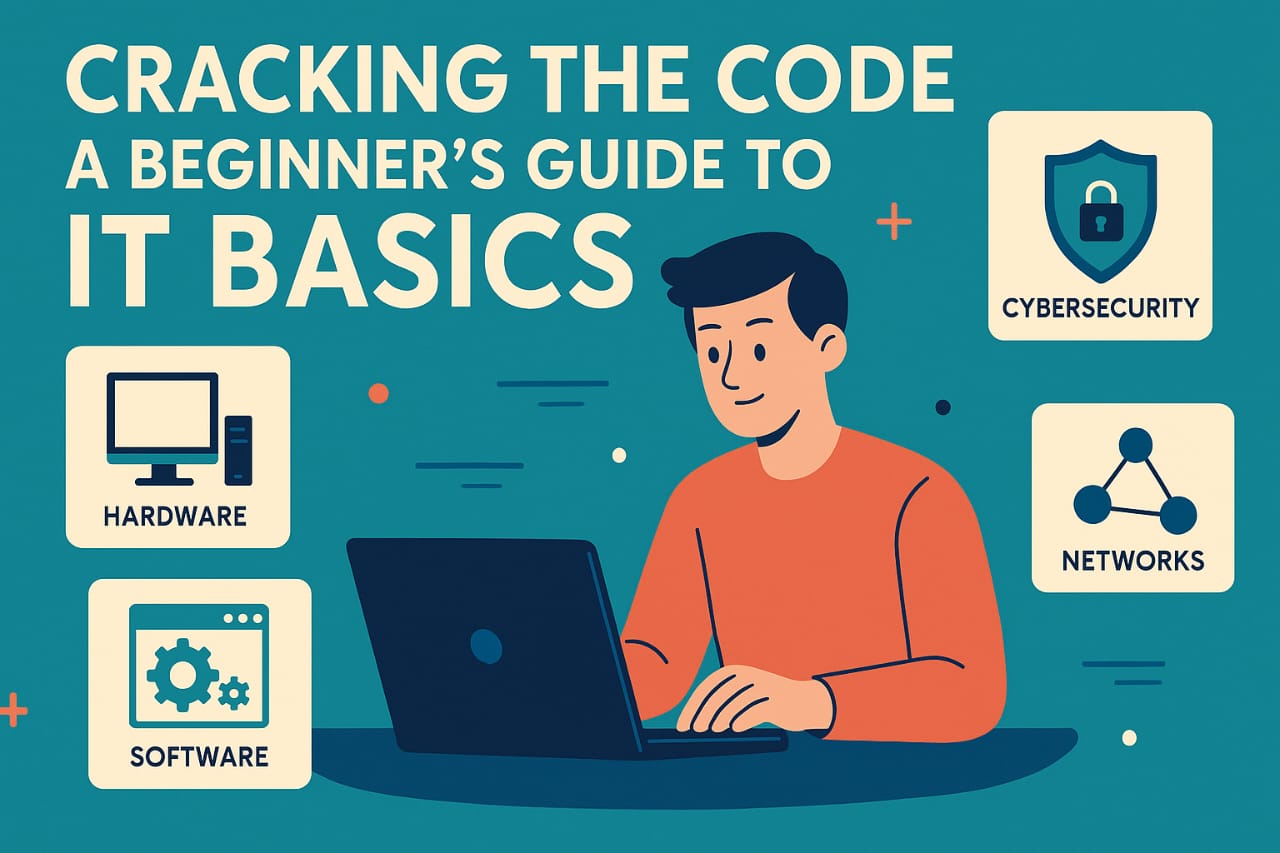Introduction
Think of the digital world as a living, breathing city — buzzing with activity, powered by systems, connected by invisible roads. Now, what keeps this city running? That’s Information Technology (IT).
From the moment you tap a phone screen to the instant a file is saved in the cloud, IT is at work — silently, efficiently, and everywhere.
In this blog, we’re breaking down IT basics in a way that’s simple, creative, and actually fun to read. Whether you’re a curious learner, a student, or someone starting a career in tech, this guide will give you the foundation you need to speak the language of the future.
🔍 What Is Information Technology?
Information Technology (IT) is the use of computers, networks, software, and systems to manage and process information.
In simple words:
👉 IT is how we use technology to store, share, create, and protect data.
It’s not just about fixing computers — it’s about creating the systems that run websites, apps, banks, hospitals, schools, and nearly everything digital.
🧱 The Building Blocks of IT
Let’s break down the basic components of IT — the tools and systems that work together behind the scenes.
1. Hardware
This is the physical part of technology — the stuff you can touch.
Computer hardware basics:
- Computers (laptops/desktops)
- Servers
- Keyboards, mouse, monitors
- Mobile devices
- Routers and modems
Keyword: computer hardware basics
2. Software
Software is the invisible brain of your devices — the programs and applications that tell the hardware what to do.
Types of software in IT:
- Operating systems (like Windows, macOS, Linux)
- Applications (MS Word, Photoshop, Zoom)
- Web browsers (Chrome, Firefox)
- Programming tools
Keyword: types of software in IT
3. Networks
A network is a group of connected devices that share information. It’s how your phone sends a message or your laptop accesses the internet.
Computer networking basics:
- LAN (Local Area Network)
- WAN (Wide Area Network)
- Wi-Fi
- The Internet (yes, the big one!)
4. Data
Data is the core of IT — it’s what we store, move, analyze, and protect. Think of it as the digital “fuel” that powers the tech world.
Data comes in many forms:
Texts, photos, audio files, videos, spreadsheets, etc.
5. Cybersecurity
Where there’s data, there must be protection. Cybersecurity is all about keeping digital information safe from hackers, viruses, and unauthorized access.
Cybersecurity basics for beginners:
- Passwords
- Antivirus software
- Firewalls
- Two-factor authentication
💻 What Does an IT Professional Do?
IT professionals are the digital architects of our world. They don’t just fix tech problems — they design systems, secure data, build networks, and create software that powers everyday life.
IT career paths:
- IT Support Specialist – helps people solve tech problems
- Network Administrator – manages and protects networks
- Web Developer – builds websites and apps
- System Analyst – finds better ways to use tech in business
- Cybersecurity Analyst – protects data from threats
⚙️ Real-Life Examples of IT in Action
Let’s connect the dots — here’s uses of IT in daily life:
- Using Google Drive to store files = cloud computing
- Paying with a credit card online = secure networks + encryption
- FaceTiming with a friend = networking + software
- Watching Netflix = data streaming + servers + apps
- Online classes = learning management systems + internet
🚀 Why Learning IT Basics Matters
Understanding IT basics isn’t just for techies. It gives you superpowers in the modern world:
- You can solve your own tech issues
- You can build a future-proof career
- You can protect your data and privacy
- You can understand how the world works
Whether you want to be a developer, start a business, or just stay relevant — tech literacy is no longer optional. It’s essential.
📈 A Quick Look at the IT Ecosystem
| Component | What It Does | Real-Life Example |
|---|---|---|
| Hardware | Runs the physical side of tech | Your laptop, phone, printer |
| Software | Tells the hardware what to do | Microsoft Word, Instagram, Photoshop |
| Networking | Connects devices to share data | Wi-Fi, LAN, 4G/5G |
| Data | Stores and powers decisions | Google Sheets, YouTube videos |
| Cybersecurity | Protects information and systems | Antivirus, Firewalls, Passwords |
🎯 Final Thoughts: IT Is for Everyone
You don’t need to be a coder or a tech wizard to understand the basics of IT. In fact, learning just a little about hardware, software, data, and security can unlock huge opportunities in school, business, and daily life.
In a world that runs on screens, IT is your passport to staying connected, competitive, and creative.





Comments are closed